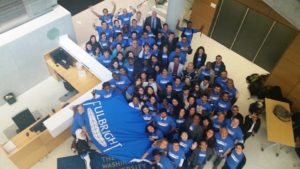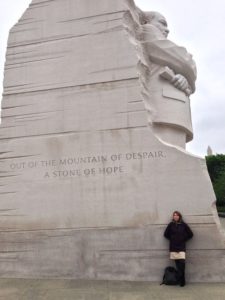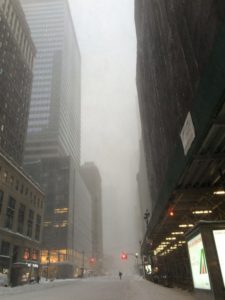
As soon as I finished studying fine arts at Complutense University of Madrid, I realized I wanted to do more than creating artworks but to help others empower their voices. I asked for advice to some faculties at my home university back in Madrid about the impact of globalization in our society and the role of culture. I did some research about specific universities I would like to go and few months later, an intuition, became a life decision: I was accepted at the art education program at the New York University.
I was very happy and more because I had the Fulbright support to do it. At NYU, my professors welcomed me as friends. This is very important because one thing I really appreciate from the United States education system is that it is inquiry based, which means that critical thinking is extremely important, so you better talk, and never wait to be called out. They expect you to have autonomy, be a free thinker, connect different areas of knowledge and do not agree with all you are asked to read (that can sometimes be about 200 pages per week) During my stay at the US, I also had the chance to discuss about education and social justice with 91 Fulbrighters and faculty from the George Washington University during an enrichment seminar sponsored by Fulbright. Among relevant topics we all agreed that education is in crisis, worldwide. In most nations, teaching is not a well paid job and it is certainly not attractive for young people because they are more interested in being economically successful.

In the case of art education, there are also many popular beliefs which do not encourage many people to move on that direction. Firstly, the lack jobs for art teachers in Spain is a main issue. Secondly, if you are an art teacher there’s an expectation from parents who think you can teach their kids to become the next Picasso, Velázques, Goya, Antonio Lopez, you name it…Thirdly, and that one comes with a weird look, people think you are a failed artist and that’s why you want to teach. What’s more, I can’t blame on people because I had that kind of teacher who helped to create the myth by doing exactly what I’ve just described. So, my questions to challenge these beliefs are: What if I am not interested in my own success but the future generation’s? What tool do you think Picasso used to create? It was not just painting but using creativity just as Leonardo did and thrived with his inventions. It was music that Einstein used as inspiration and had his ideas and the list goes on.
In addition to that, many contemporary artists such as Pablo Helguera (director of education department at MoMA) and Luis Camnitzer among others, are working using art as education. NYU also brings artists to classes so you can discuss with them about what’s going on in contemporary art, today. There are more artists who are doing social action research and making use of important data to expose social issues as internationally recognized chinese artist and activist Ai Weiwei does. Art is not just the use and transference of techniques, nor acquiring the ability to do an aesthetically well done object. Art is a place that hosts critical thinking and creativity among others skills such as learning different techniques. Art can open dialogues about deep issues. Art can help reduce bullying and other inequalities. Art is education.

Another important experience from my Fulbright scholarship was to have the chance to discuss with the cultural counselor of Finland in Washington DC the finnish education model and how the country thrived at international level. He stated that Finland invested in teacher’s training and the government trusts them as the ground force for the country’s success. And, in case you might ask, the reason I didn’t I go to Finland, well, I saw a great opportunity in learning about the impact of globalization at the core of it, New York City. There, I experienced how diversity brings social issues into the multicultural classrooms daily and how teachers can challenge hierarchies based on gender, class and ethnicity. Everywhere cultures are selective, and education not only happens at school, but at museums, media, history books, family, government, etc. biasing inequalities. We learn at all levels and that’s why educating by analyzing our culture is important.

My Fulbright experience helped me to see these challenges as opportunities for understanding applying the UN Children’s rights and UN sustainable goals into my teaching vision. So if as educators can let students have a space in which their soul can be free, we will be encouraging their individual voice that can rewrite the eroded community’s identity gradually. We need global understanding to avoid cultural conflicts and that is something I did as part of my research during this year at the US.. My questions were: How are schools creating spaces in which students can learn how to read today’s world? What is the role of the art as an interdisciplinary tool in which the other disciplines meet? What can we learn from other educational contexts in order to teach in multicultural classrooms? How are we hosting social justice conversations about immigration, discrimination against class, gender, ethnicity and special needs?
Being part of the Fulbright community, I learned through experience: I shared, and yes I worked very hard on a tight schedule writing reflective papers, preparing lessons and being part of the crazy but fascinating New York routine. Today, I am preparing to go back to Spain, I have my fears as a new student but that’s another challenge that I want to turn into an opportunity to build a bridge for global understanding and make a better world. As Machado said: “we make the road by walking”. Thanks Fulbright for believing in me.
Letizia Balzi Costa
2015 Fulbright / Spanish Ministry of Education
NYU Steinhardt